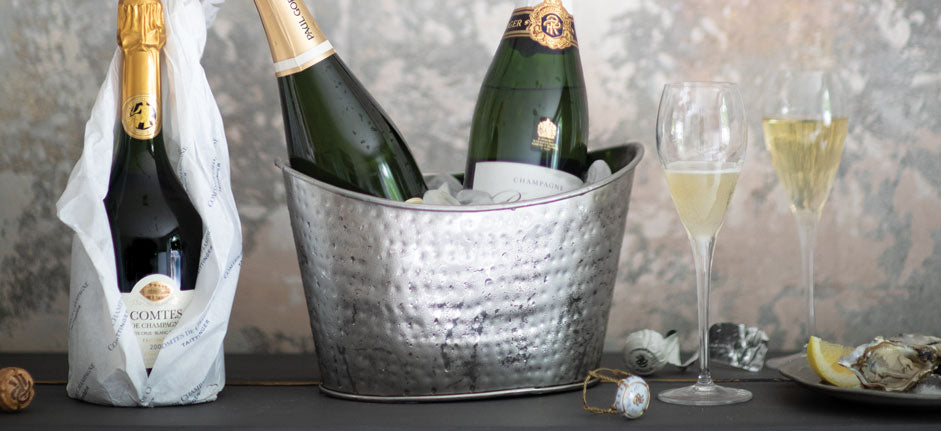
At what temperature should you serve wine? The instinctive reply might be that white and rosé wines should be served chilled and reds at room temperature. While not incorrect, it is also not quite that simple and as far as fine wine is concerned, this approximation doesn't do it justice.
In order to really enjoy a great wine, the details are fundamental, and temperature greatly influences the perception of quality and taste. Indeed, the temperature you serve a wine at is just as important as glassware and storage. It’s no coincidence that Laurent Ponsot, one of the world’s most famous Burgundian winemakers, has invented a revolutionary high-tech packaging & labelling system that gives you, amongst other things, information on the bottle temperature since its release from the domaine.

Temperature is like a conductor of an orchestra, creating harmony and balance. It has a huge impact on the perfume of the wine. Organoleptic characteristics change depending on if a wine is served either too cold or too warm: too cold and you cannot smell the aromas, while the warmer it is, the more accentuated the wine’s perfume becomes.
There is a corresponding impact on the palate. If a white wine is served chilled, the sensation of acidity and the wine’s varietal aromatics are enhanced. Cold temperatures can also make tannins more pronounced, which is not necessarily a good thing. This is why red wines, especially aged and complex ones, are served at a higher temperature. However, when a wine is served too warm, the alcohol can dominate the palate which can be unpleasant.

WHICH TEMPERATURE FOR WHICH WINE?
ICE COLD FOR SPARKLING WINE — 6-10°C
(Vintage Champagne should be served a bit warmer than NV champagne so their complexity is better expressed)
You can refrigerate the bottle for at least 3 hours, freeze the bottle for about an hour (set a reminder to avoid an unwanted explosion) or put it in an ice bucket for 30 minutes, personally this is my favourite method and a true time saver! Once you have opened the bottle and served the first glass,place the bottle on ice until you have finished. The relatively cold temperature helps to provide the right perception of fizz and the bubbles will be pleasant and creamy. Drink the same Champagne or sparkling wine at a higher temperature and you’ll most likely find it too acidic, and the bubbles heavy and overwhelming. As a result the wine could seem a bit boring or flabby.

COLD FOR WHITE WINE— 8-12°C AND ROSÉS —12-14°C
(the more complex and aged the warmer it should be)
Whites and rosés both need to be served cold to have that light freshness and lovely dancing acidity on your palate. I would refrigerate the bottle for 2.5-3 hours in the fridge or if you are running low on time you can place the bottle in the freezer for around 20-30 minutes. Don’t leave it too long though as the wine should not be freezing cold. Depending on where you are drinking your wine, after opening the bottle and pouring everyone a glass (not too full so you can let the wine swirl), you can either store it in a portable wine cooler (if it has already been frozen), a glacette (a wine cooler, often silver, that maintains the temperature of an already chilled bottle of wine rather than cooling it) or you can leave it out, enjoying the changing aromas as it gradually warms up. Never let it to get too warm or it could become flabby. The warmer temperature doesn’t change the acidity of the wine but the perception of the acidity on your palate. The fresh sensation you get from a chilled white wine or rosé comes in fact from the acidity that is enhanced by the cool temperature.

COOL FOR RED WINE — 15-18°C
Serving at “room temperature” is the most common mistake with red wine, because temperatures can vary massively according to the room, place, season and country you are in. Red wines should be drunk at cellar temperature - 18°C or a slightly cooler 16°C - to give a pleasantly balanced sensation: the alcohol won’t be overwhelming, the tannins will have a nice texture, the acidity will be elevated but not overwhelming and the sapidity enhanced. If you don’t have a cellar, and your bottle is at room temperature, put it in the fridge for 30 minutes to an hour before serving. Once you open the bottle, you can either decant or pour the first glasses and leave the wine out on the table to slowly warm, but if it is summer or the room you are in is very hot, by all means keep it in a glacette.

Ultimately, as with so many aspects of wine consumption and enjoyment, it depends on your personal preferences, so it is best to experiment until you find the method that suits you. If you are not sure, buy a wine thermometer. It is a quick and easy way to know if your wine has reached the ideal temperature.


